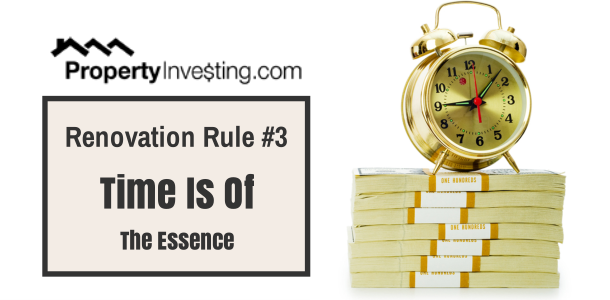Renovations The Right Way
Renovations The Right Way
Renovating real estate has always been a popular way for investors to combine a love of power tools with a desire to make money. And in recent times a new generation of would-be rehabbers has been captivated by realty TV shows that portray relatively easy profits, made by relatively pretty people, in relatively quick time.
However, professional renovators – investors who have carved a niche from strategically buying, adding value, and then exiting for profit – will all tell you that what you see on TV, and what you should expect in real life, are completely different. Indeed, you might be surprised to learn that what makes good TV usually makes for terrible investing.
This article is published to help you to separate myths from facts, and to provide you with three simple tips to stimulate further thought.
Renovating – The Basics
The basic mantra to getting rich from renovating is this:
Always add more in perceived value than actual cost
In order to make a profit from your renovation project, each dollar invested needs to return more than a dollar of additional value to property’s sale price. If not then you’re eating into your profit margin, up until the point where there is no more profit and you make a loss.
The science of renovating riches is therefore a function of knowing how to add the most perceived value for the least actual cost.
It should be noted that perceived value is not in the mind of the investor, but instead, and as explained below, in the mind of the person who is going to acquire the post-renovated property.
If you’re wondering ‘Well that sounds nice, but what adds the most value?’, then keep these renovation rules in mind:
Renovation Rule #1: Stick to strategic, not structural
Unless you’re an experienced renovator, stick to strategic renovations – projects where you concentrate on adding cosmetic value, and get in and out within six months.
In such cases, a good rule of thumb is to look to improve anything you can see, feel (touch) or smell, and to concentrate on highly emotive areas (such as finishes – new paint, new carpet, etc.) first. With that in mind, seek to prioritise areas where people live or spend the majority of their time.
As a starting point, try to conserve the shell as much as possible and renovate around it. An example is to keep the kitchen shell, but to replace the cupboards and bench tops.
If you begin making structural improvements (i.e. altering the sub-floor, roof, electrical, plumbing, etc) then it’s very easy to incur a lot of buck for very little bang. After all, how much extra can you charge for a new hot water service, or new central heating unit, or latest evaporative ducted cooling (when perhaps a split system wall unit would suffice).
Renovation Rule #2: Start with your end
A big mistake novice renovators make is that they focus on the property being renovated rather than the person who is going to buy (or live) in it.
For instance, compare these two approaches:
- Investor one buys a ‘renovators delight’, renovates the property to a standard and taste that they feel is tasteful, and, once complete, tries to sell the property for a profit.
- Investor Two sees the same property, but before buying, seeks further clarity about who might buy the renovated property, what that person might desire to make their enjoyment of the property more convenient or comfortable, and what might the target market pay for the post-renovated dwelling,
In other words, savvy renovators start with the end (next purchaser / target market), and end with the start (property under investigation). The alternative is to speculate, and that can work, but it adds a lot more risk.
Over-capitalising, or adding more cost than perceived value,
is the enemy of every renovator.
An easy way to over-capitalise is to renovate above the budget of the proposed target market, such that they cannot afford it, and such that those with the budget to buy don’t want to live in the area or feel that, even after renovation, the property is tawdry to their tastes.
Renovation Rule #3: Time is of the essence
Interest is a silent killer of renovation profits. Delays caused by trades not being synchronised, permits taking longer to obtain, dwellings taking longer to sell, etc. all add to the time needed to complete the project, and every delay results in more interest expense on your debt.
Consider this: a delay on a renovation project with a $500,000 loan incurring interest at 6% per annum will see your ultimate profit chiselled away by $575 each and every week, or a reduction of $2,491 per month!
A smart renovator knows this: clever project management can make (via savings) as much money as the actual renovation.
3 Tips For Renovation Success
Here are three highly useful tips for would-be renovators:
Tip #1: Outsource
The natural tendency of the novice renovator is to either do the work themselves, or else rope in family and friends under the guise of a mandatory working bee, in order to save money.
Perhaps this approach is okay for a first project while you learn the ropes, or if you want to be a handyperson who tinkers with investing, but professional investors use their minds, not their power tools.
So, instead of getting dirty and dusty, a professional investor uses his or her time selecting projects, performing due diligence, refining their success systems, understanding their target market, sourcing properties etc.
Investing is an intellectual exercise,
not a physical challenge.
Now, of course you can make (more) money if you do the work! But that gain comes from a labour saving, not an investing profit, and what savvy investors give up in labour savings, they make back in additional volume from having multiple projects on the go at once.
Tip #2: Renovation Budgeting
Gut feel is a poor substitute for accurate renovation budgeting.
Statements like “could, should, might, feel, maybe, etc.” need to be avoided wherever possible, and instead, each planned renovation should be costed as accurately as possible so you know, down to the dollar, what to expect rather than guessing.
Typically, if you found a property you felt might be a suitable investment, it would be prudent to get it under contract with a due diligence clause of (say) 14 days at which point you would create a master plan of proposed works which you would accurately price – either via quotes with sub trades, or else with your own spreadsheet with researched cost estimates.
Please – never wing it. If in doubt, arrange the necessary time needed to make an informed decision, or pass over the opportunity because the more things you leave to chance, the more chance things will go wrong.
Tip #3: Calculations
Smart renovators know that reno riches is a matter of crunching five numbers:
Step one: Ascertain the likely post renovation sales price
This can be researched by obtaining comparable sales data, either online or from a friendly local real estate agent.
In fact, it’s a great idea to spend time in the area you plan to invest in attending open for inspections to research what features of new houses are in demand and why.
Step two: Deduct the renovation budget
As mentioned earlier, if you don’t know what a planned improvement is going to cost, get a quote! Every dollar you under-estimate is a dollar less of profit in your pocket
Step three: Deduct the buy, sell and holding costs
Buying costs include stamp duty, inspections, legals, loan costs, etc. Holding costs include interest, rates, maintenance, etc. Selling costs include agent commission, advertising, etc.
Step four: Deduct the desired profit margin
Don’t forget to pay yourself! Only you can nominate your desired profit, but it needs to reflect your risk and effort. Furthermore, this profit will become your ‘safety margin’ to absorb cost overruns. The taxation consequences of the investment, including GST, need to be considered too.
Step five: Arrive at the maximum purchase price
After beginning with the end price and deducting steps two, three and four, you are left with your maximum purchase price.
Inaccuracy with any of the above numbers puts your profit at risk.
Summary
You could be forgiven for watching reality TV shows that have you believing that renovating is fun and easy, and that everyone makes profit.
But that’s not true. Like any investing, the more skill and expertise you have, the lower the risk and effort needed to make significant profits.
The biggest mistake made when renovating is to focus on the property being improved, rather than the person who will be buying the dwelling. Remember that it is people, not properties, that carry cheque-books and if you want to make a profit you must add more in perceived value in the purchaser’s eyes than your actual purchase, sale, holding and renovation costs.
Can you recount the renovation mantra? It will be your recipe for success.









Got something to say? Post a comment...
You must be logged in to post a comment.